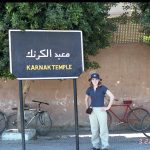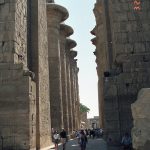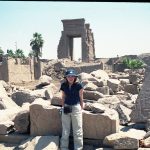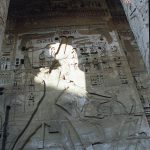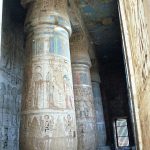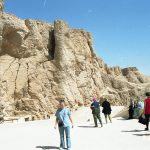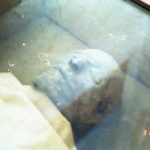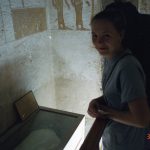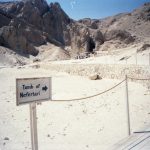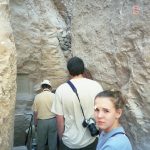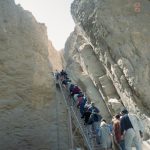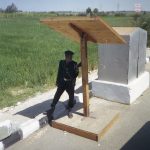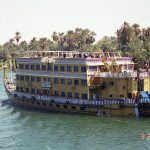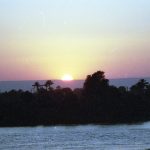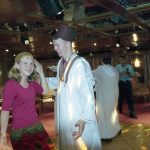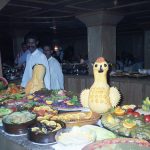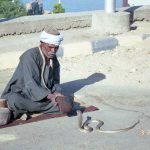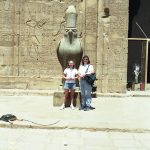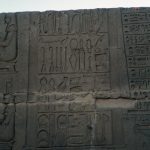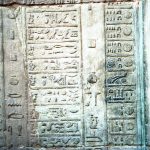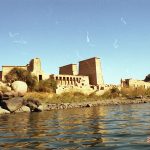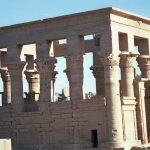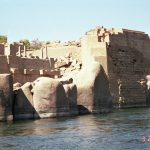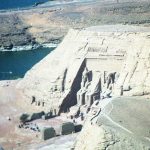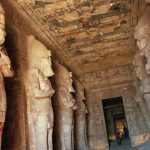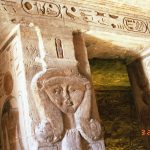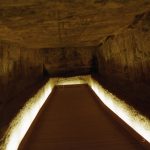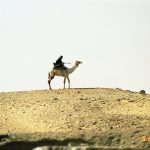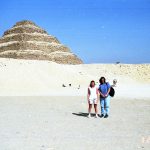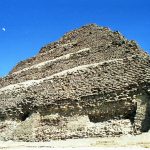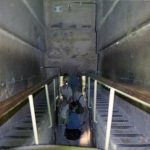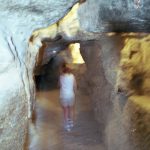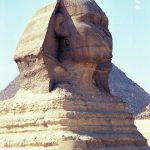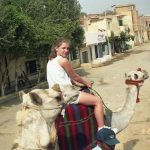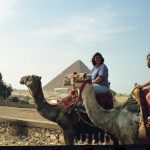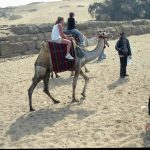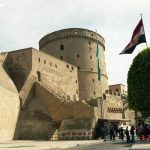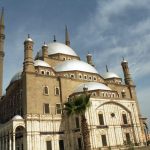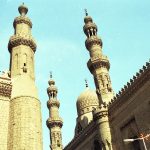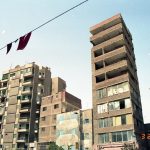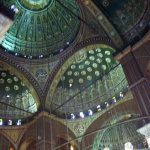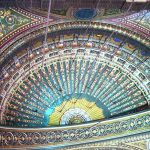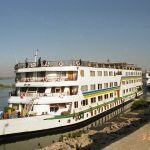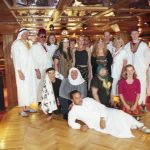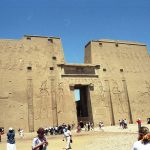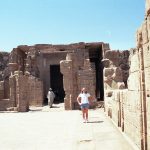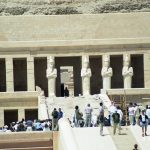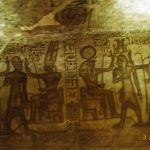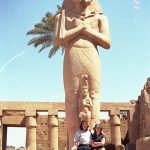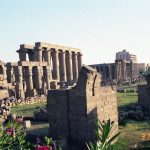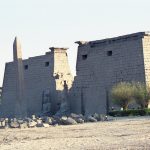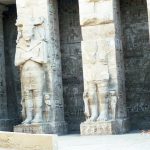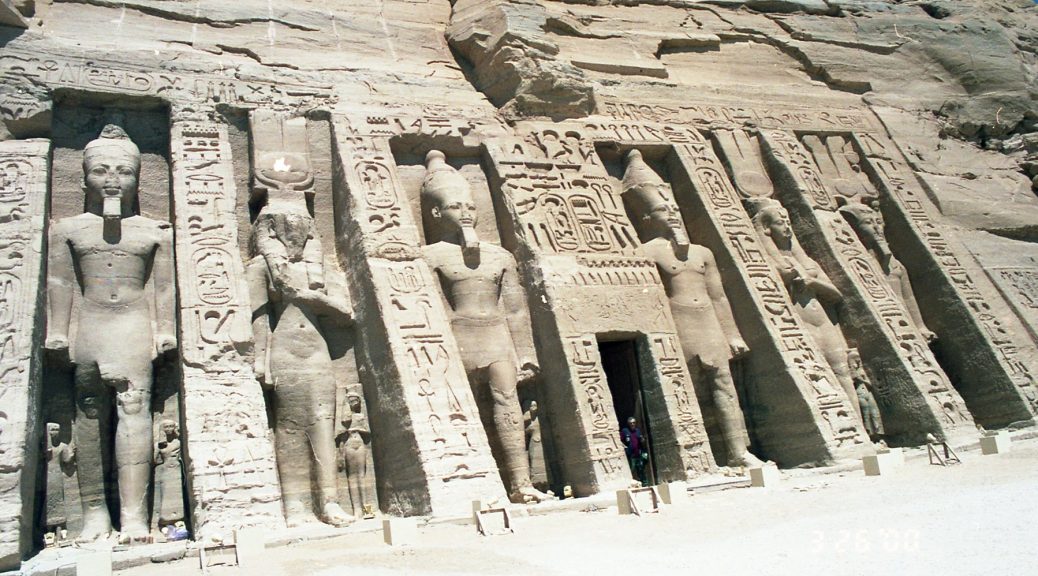
Egypt
Alex and I made our first visit to Africa, visiting Egypt, in 2000. I didn’t feel as comfortable traveling alone then, or even with a 13-year-old, so we booked a package tour with Trafalgar.
Wednesday, March 21. we left from Chicago around 2040 for Paris. We arrived midday and after a two hour layover flew to Cairo. We were picked up at the airport. The company offered different levels of hotel on this trip; I paid for the middle level. Our hotel was the last to be dropped off, we had about an hour drive from the airport.
We stayed in the Oasis before and after our Nile cruise. It had gorgeous grounds and a nice pool. But the rooms were not very comfortable or clean.
Thursday, March 23. We had a very short night. We had to wake up at 0430 to get back to the airport for a 0800 flight to Luxor. Our luggage was taken to our boat while we visited Karnak. Overall, there were about 75 people on the tour, but we were broken into groups of 25 with individual guides and buses and boats. Our guide, Akram (call me “Bill”) Monchim, had a masters in Egyptology/Egyptian History. He was so knowledgable and made the trip really interesting, helping us understand about 5000 years of history and architecture.
Karnak is the largest temple complex ever built. The Temple of Karnak is actually three main temples, smaller enclosed temples, and several outer temples located about three kilometers north of Luxor on 247 acres of land. The ancient name was Ipet-isut, “The Most Select (or Sacred) of Places”. Divided into three major precincts, it is dedicated to Amun-Re, a solar deity who maintained the balance and functioning of the world, his wife Mut, a goddess of queenship, and Monthu, the warrior god.
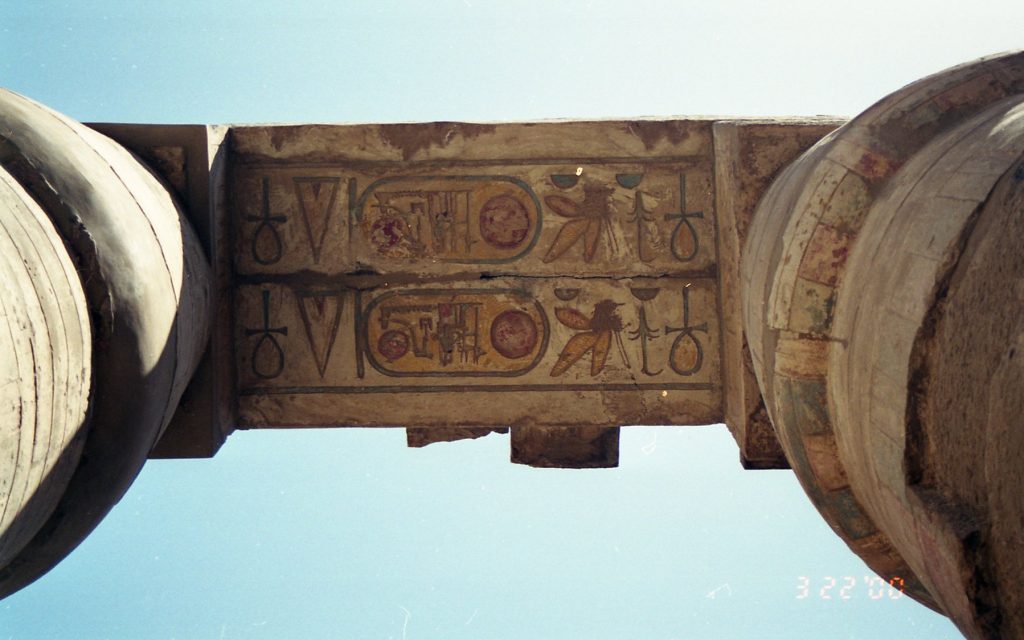
An avenue of ram-headed sphinxes, that used to lead all the way to Luxor, opens the way to the south entrance. The temple complex has buildings from the 12th dynasty through the 30th dynasty, with most building taking place in the 18th and 19th dynasties, around 1600 BC to 1200 BC.

This was the first temple we saw in Egypt on our first morning in the country, I was really awed by its size, it is huge! Alex and I both enjoyed our morning here; especially as many of the later temples we saw began to look alike. We left around 1230 for our riverboat, the SS Media.
Alex was expecting a big cruise ship and was a little disappointed with the simple amenities on a small riverboat. But we had a very comfortable room with a nice big window. Lunch was served at 1300, then we met at 1530 to return to see the Luxor Temple, ancient Thebes. Bill showed us around then left us free to wander this very large temple complex.
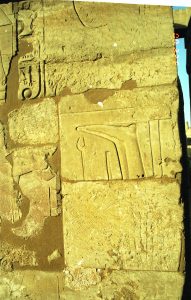
Luxor is dedicated to the Thebian Triad, Amun-Re, Mut and Khonsu. During the 4th century, Christians had a ban on “pagan cults” and built several churches within the temple. They reassembled fallen stones without any concern for how they actually fit together. You can see this in a number of walls and columns, which look like a badly put together puzzle. In the 12th c. the Abd al-Haggag mosque was erected at the site and locals have refused to let it be torn down. The obelisk that stands in Paris’s Place de la Concorde was taken from Luxor.
Known as antiquity as Thebes, Luxor takes its names from the Arabic Al Uqsor or “The Palaces”. The temple of Luxor built from 1390-323 BC is much easier to explore and enjoy even if not as impressive as Karnak. Amenhotep III started the temple, then Ramses II added to it a century later. The Avenue of Sphinxes leading from here to Karnak was added almost a 1000 years later.
We returned to the boat, catching the bus at 1800. After dinner on the boat, we returned to Karnak for a Sound and Light show. They just had some spotlights displayed on a few of the walls and monuments, not anything special, also very cold.
Friday, March 24th. We were up early again, 0600. We needed an early start to the Valley of Kings and Queens.
We stopped at Medinet Habu. The mortuary temple of Ramses III was very impressive. Most people pronounce this as Ram-zees but Bill told us it should be Ra Meses or son of Ra.
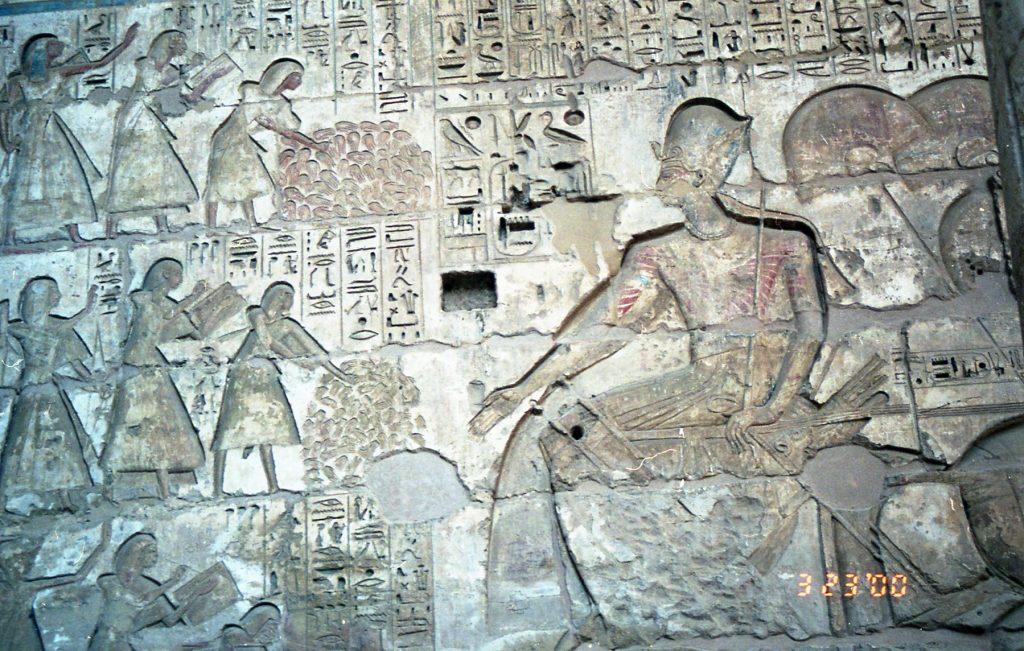
It is about 4 miles from the Valley of Kings, near the foot of the Theban Hills at the southern end of western Thebes. The mortuary temple is the best preserved temple at Thebes. Some of the walls and columns still had the original paint, after 3500 years. The wall reliefs are amazing. One shows Ramses cutting the heads off his enemies, another shows servants counting the cut off hands of slain enemies. Later, they stopped collecting hands, they were too hard to “match” and starting cutting off male genitalia. There is a relief showing this. We saw the cartouche of Ramses III; a cartouche is an oval frame enclosing the name of the pharaoh. They used an oval because they considered the corners of a square or rectangle bad luck, showing endings.
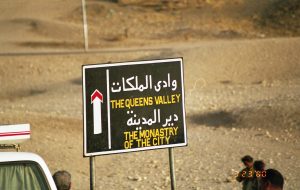 Just hearing “Valley of Kings” conjures up all the mysteries of Egypt, with deserts, ancient tombs, mummies, vast riches. It’s all here in this isolated valley; 62 tombs, from Thutmose I to Ramses XI are hidden in these hills. We got tickets for 3 of the tombs, we also had to buy photography/camera tickets as well. I bought one for 10 Egyptian Pounds, later realizing I was supposed to buy one for each tomb. We saw Ramses IX together. Bill recommended both tombs of Seti I and Thutmose III. We also had to buy a separate ticket for the most famous, Tut Ankh Amun. I wasn’t going to come to Egypt and not see King Tut’s tomb, so bought this for us.
Just hearing “Valley of Kings” conjures up all the mysteries of Egypt, with deserts, ancient tombs, mummies, vast riches. It’s all here in this isolated valley; 62 tombs, from Thutmose I to Ramses XI are hidden in these hills. We got tickets for 3 of the tombs, we also had to buy photography/camera tickets as well. I bought one for 10 Egyptian Pounds, later realizing I was supposed to buy one for each tomb. We saw Ramses IX together. Bill recommended both tombs of Seti I and Thutmose III. We also had to buy a separate ticket for the most famous, Tut Ankh Amun. I wasn’t going to come to Egypt and not see King Tut’s tomb, so bought this for us.
We hiked off after visiting Ramses IX fo find Seti I. His mummy is still in the tomb and I got some good pictures. Next we took the long and step climb to Thutmose III’s tomb, up a long steep flight of stairs. The view from the tomb across the valley is great. Thutmose’s tomb is 3 levels deep. The bottom chamber is where his sarcophagus is located, there are very narrow stairs inside and we almost got trapped down there as a large group came in and didn’t seem to want anyone to come up the stairs. It got very crowded until another in my group yelled up STOP, and she forced her way up the stairs. She stopped them at the top and we finally got out.
After Thutmose we visited King Tut! I would have loved to take photos here, but no photography was allowed, they did not sell camera tickets. His tomb consists of 5 rooms, passageway, antechamber, burial chamber, treasury room and annex. All that is left, besides the decorations on the walls, which are scenes from the Book of Amduat, is the outermost sarcophagus. The rest of the treasure found here is in the Egyptian Museum in Cairo.
After leaving the Valley of Kings, we stopped to see the temple of Amenhotep III. All that is left are the seated statues, called the Colossi of Memnon. They are about 3400 years old and are located across the Nile from the city of Luxor. Named by the Greeks for the myth of Memnon, who was meeting his mother, Eros (Dawn), when he was slain by Achilles. The statues used to “sing softly at dawn” after an earthquake caused a crack in the stone.
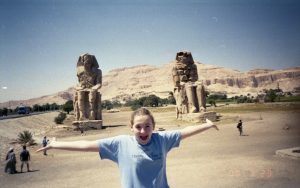
Hatshepsut, daughter of Thutmose I, sister of Thutmose II, aunt to Thutmose III, was the most important woman to ever rule Egypt as pharaoh. Instead of waging war, she consolidated the country, building monuments, and organizing expeditions to neighboring countries to bring myrrh, incense and offerings to the gods. Her supreme achievement was Deir al-Barhi, the mortuary temple of Hatshepsut and dedicated to Amon-Re. It is believed to be the finest piece of architecture on the planet for its harmony with its surroundings. Her nephew, Thutmose III, hated his aunt for declaring herself regent after his father’s death and when he became pharaoh, tried to literally erase her name from all the monuments. There are a number of obelisks and walls with her name chiseled off of the stone. After Deir al-Bahari, we continued to the Valley of Queens and saw the tomb of Queen Tyti and Prince Amon-her-Khopechef, son of Ramses III.
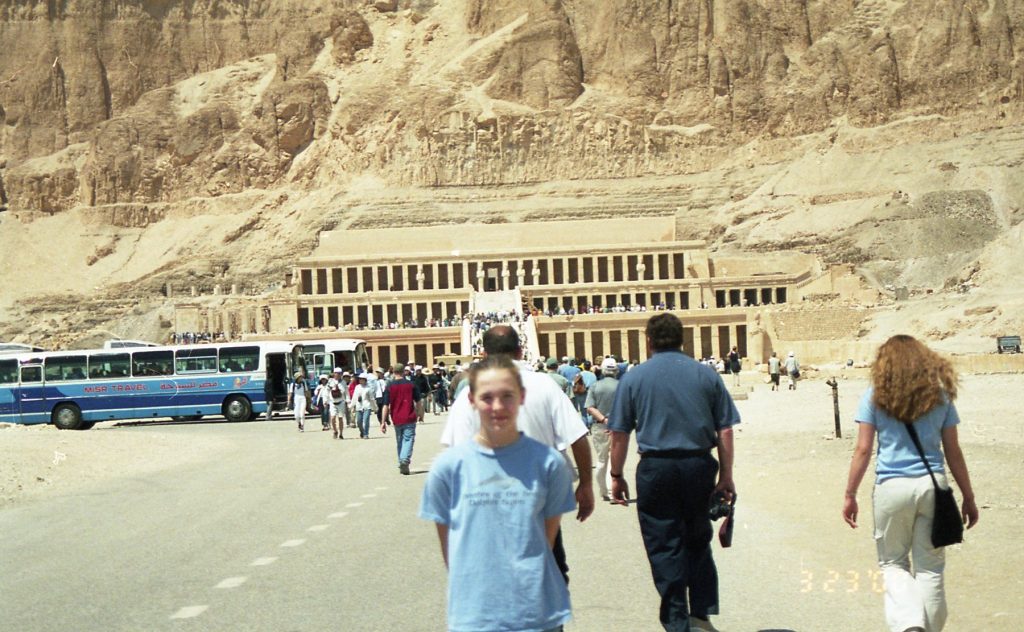
After this long and exciting day, we returned to the boat on the opposite shore of the Nile. We had dinner on board. Today we actually began sailing up the Nile, south, to our next stop of Edfu. Around 2100 we arrived at the locks of the old dam and had a very long wait. There were boats “parked” all over the the river waiting their turn through the locks. While waiting a large number of vendors came out on boats and tried to sell us things since we were on the top deck enjoying the evening and nice weather. One vendor even tried tossing an item to Paul then got very upset when Paul wasn’t going to pay him. Paul returned the item.
Alex was the youngest at 13 but Paul, 18, was traveling with his dad, Barry. They were from Ohio. There was a nice family from California, Wes and Wanda, with their adult children, Krysi, Monika, and Mark, 27, 21, and 25. Alex enjoyed having these “young” people on board.
Saturday, March 25. We arrived late at Edfu, around 1030 because of the traffic at the lock. We took a horse and carriage from the dock to the temple in Edfu as it it quite a distance from the dock. The temple is dedicated to the falcon god, Horus. Edfu is the most intact and best preserved temple in all of Egypt, built between 237 BCE and 57 BCE, during the reign of Cleopatra VII.
To get to the temple we had to almost fight our way through very agressive vendors lining the street. They would walk in front of you, “come into my shop”, “very good deals”, and wouldn’t let us pass. I would have like to browse here and other places throughout Egypt but if you walked into a shop it was very hard to leave without a purchase. I just wanted to look so it was easier to keep walking.
We were supposed to sail at 1300 but one of the other passengers thought she had to be at the carriage then and didn’t arrive until 1330. She was one of those people who was almost always late, only concerned with shopping. People like this, for me, make it hard to enjoy group travel.
We spent the rest of the afternoon sailing to Kom Ombo. We arrived around 1900. We walked up to see it in the moonlight. The temple was just around a bend from the Nile and our boat.
Alex also wanted to visit the vendors to buy some items for a costume party that evening. She bought a coin headdress that she wore with her wrap around skirt from Bangkok. Quite international! Most of the men just dressed in the long white robes the locals wear, except with flip flops or tennis shoes. They had a lot of games, dancing and more, a fun evening.
Sunday, March 26. We visited Kom Ombo temple early, from 0630 to 0800, so we could sail for Aswan immediately after.
The temple of Kom Ombo is a double temple dedicate to the gods Horus (or Haroeris), the falcon-headed god, and Sobek, the crocodile-headed god of fertility and creator of the world.
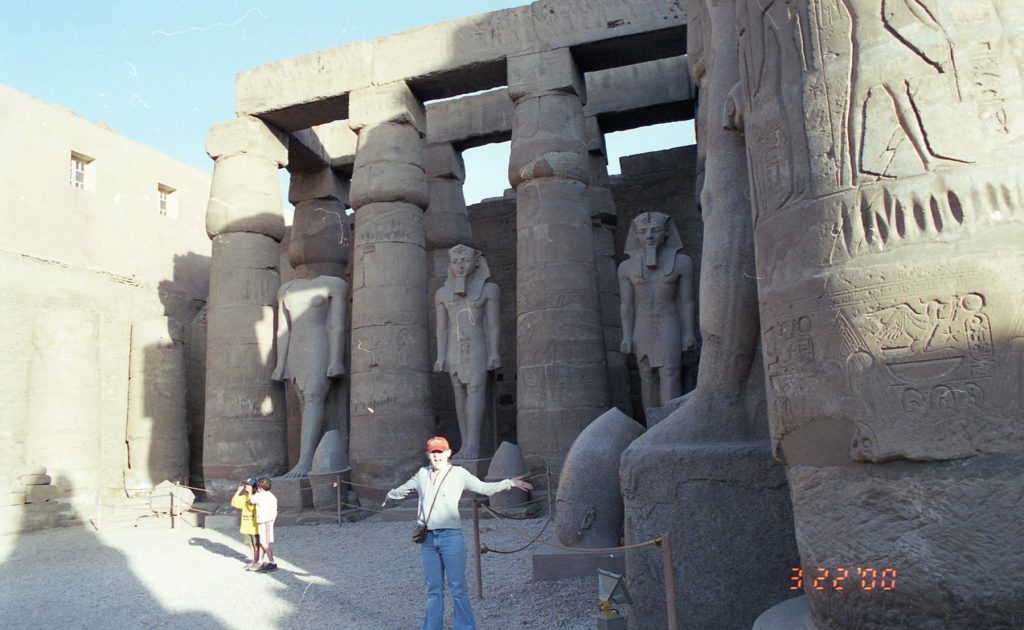
Crocodiles were kept at the temple and regarded as semi-divine. They were fed on the finest foods, provided with golden earrings, and given elaborate manicures which included gilded nails. When the crocodiles died they were mummified and they are on display in the museum. The temple provided some of the most interesting wall reliefs we saw. We were shown an ancient calendar, used to instruct the priest what offerings should be made to the gods in the various seasons. A slash mark indicated 1 day, a upside down U 10 days, and a wavy line was the start of a new season. Egyptians had the oldest known calendar.
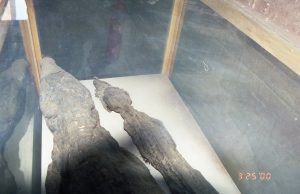
We also saw a wall of surgical instruments; most still used world wide today. Many of these instruments were dug up at the site.
We spent the reminder of the morning on deck. Alex was very bored, saying there was nothing to do. This is a small river boat, not a large cruise liner (which we’ve never been on regardless). I found it quite relaxing, comfortable chairs to lounge on, great scenery. The boat had 5 decks, the lowest deck with the kitchen and dining room, crew quarters, and engine room. The main deck had some cabins and the bar and dance area. We were on this level, the next two decks were all cabins with a gift shop on 4. The upper deck had a small pool and lots of deck chairs on the stern, the bow was covered with canvas awnings, tables, chairs, and another bar. I spent most days on the upper deck admiring the scenery and taking lots of photos and reading.
We arrived at Aswan or Assuan around 1245. They served an early lunch so we would be able to go ashore as soon as we arrived. We walked down to the dock and boarded a felucca, the big sailboats, that are all over Lake Nasser.
Begun in 1960, the High Dam at Aswan took until 1971 to complete, plus Soviet financing and 30,000 Egyptians working around the clock. Lake Nasser is the world’s largest man-made lake.
We took the felucca to see the Botanical gardens on Kitchener’s Island. We walked the entire length, about a mile, enjoying the Royal palms with their tall white trunks and beautiful flowers along a nice trail. We were met by Bill and our boat at the other end. We also sailed around Elephantine Island, named because the huge boulders look like elephants, then through the “first cataract” or rapids of the Nile to another landing where we caught a bus. The bus took us to another dock, after another “forced shopping” session. We caught a motor boat here to the island of Philae (pronounced fill-i).
Philae was one of the monuments moved to prevent flooding when the new dam was built. Dismantled and moved to the isolated island of Agilquiyya, the temple is dedicated to Isis and dates from the 4th century BC to the 1st century AD. By the time we visited, we had seen 5 or 6 temples, and, without a history degree, couldn’t discern the differences in style or age without being told the details by Bill. However, unlike most of the others surrounding by buildings, this temple was unique in that it was so isolated and peaceful. A beautiful location.
We also saw the Mausoleum of Aga Khan, spiritual leader of the Ismailis, a Shi’ite sect, who died in 1957.
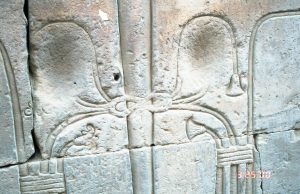
We stopped at a Papyrus “Museum” (a store). Most of my fellow passengers went to a large bazaar running the length of the river. They had a belly dancing show that the men especially enjoyed. I left early and packed up for departure the next day.
Monday, March 27. There were a number of us flying to Abu Simbel. We left at 0700 with a stop en route at the high dam before going to the airport.
Built by Ramses II in the 13th century BC, to show his might as a living god-king, the temples at Abu Simbel are magnificent. The “Great” temple is dedicated to Ptah, Amun-Re, Re-Horakte, and Ramses II. It has a façade of four 20-meter statues of Ramses II. You can compare the size of the statues compared to the people going in the entrance. The second temple, the “Small” was built for his favorite wife, Queen Nefertari, and dedicated to Hathor, the ancient Egyptian goddess who personified the principles of feminine love, motherhood and joy. Both were moved to save them from flooding caused by building of the Aswan dam. The entire cliff was rebuilt to restore them as close as possible to the original; it cost $40 million and took four years, from 1964 to 1968. It is a World Heritage Site.
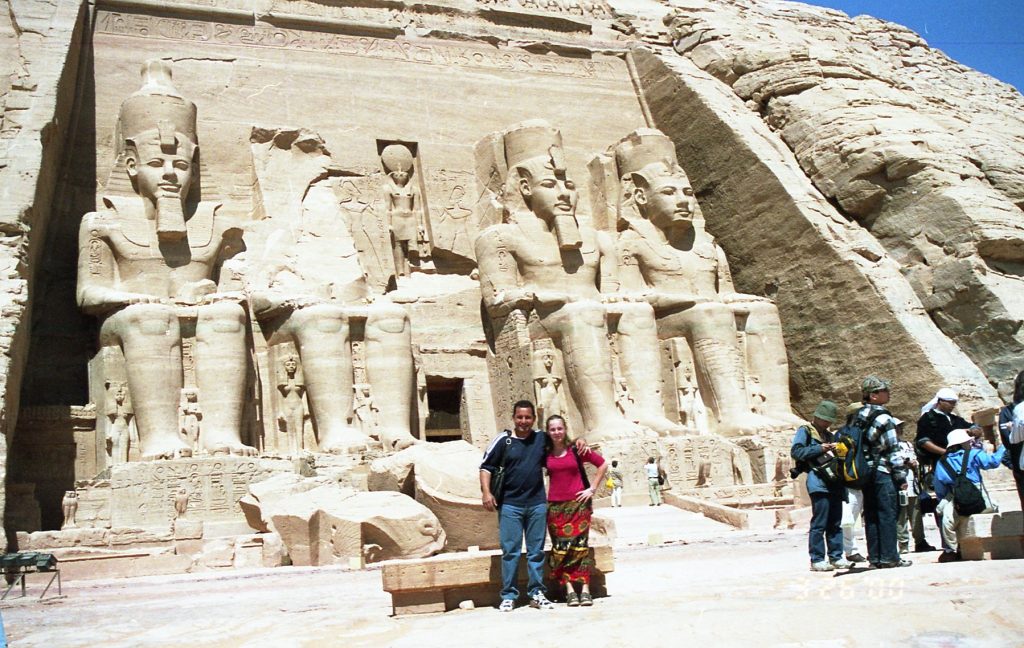
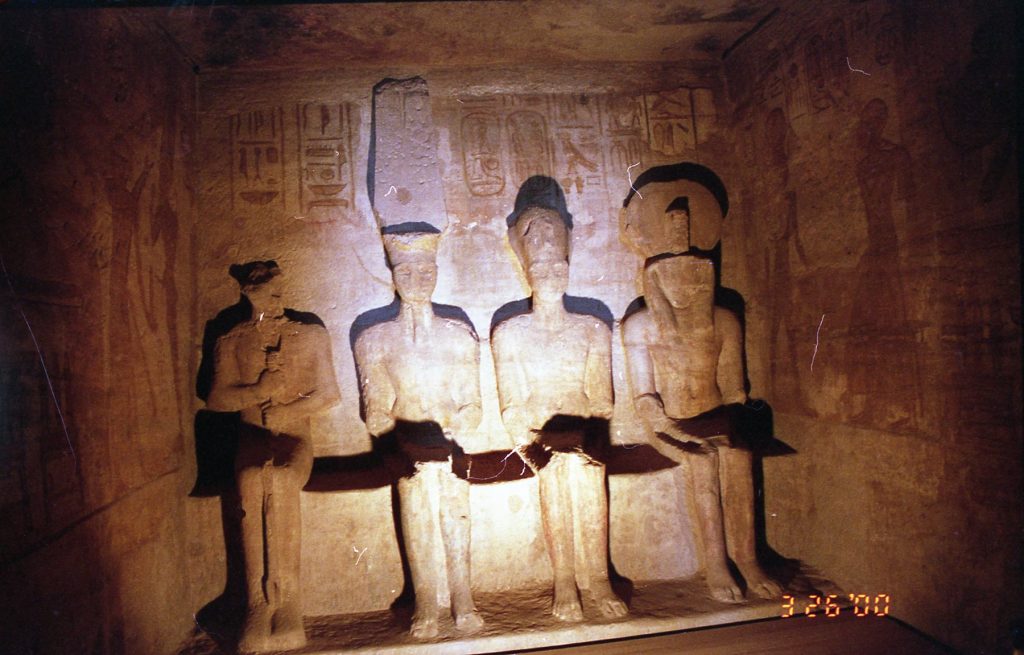
Deep in the temple are statues of the gods and Ramses II. Solar alignment occurs twice a year for 20-25 minutes at dawn on October 22 and February 22. The rising sun illuminates three of the statues. This is called “Legend of the sun”. Ra, sun god, Ammon, king of the gods, Ramses II are illuminated, Ptah, god of darkness is not illuminated.
This was not included in the tour, we paid extra for the flight, and I am so glad we did; after the pyramids, Abu Simbel was easily the best site in Egypt. After several hours, we returned via the bus to the airport. Flying into Aswan, we remained on the plane while the rest of our group boarded then we returned to Cairo arriving around 1630.
We checked in then went out to dinner with Barry and Paul, all the others in our group were at the very expensive Mena House. We went to the falafel restaurant recommended by Bill. Not good food. Egypt was really my first experience with Arabic or Middle Eastern food. Neither Alex or I enjoyed most of the meals. Certainly, it was nothing like visiting Southeast Asia where everything is delicious. When visiting Morocco in 2017, either the food is different enough or was better prepared (we weren’t on a group tour) or my tastes have changes as I really enjoyed the food in Morocco.
Tuesday, March 28. The pyramids! We started off early to Memphis. It was the first capital of a unified Egypt, founded in 3100 B.C. What was once a “great splendor” with “much work, gold and precious stones” is now a “waste and desolate place without an inhabitant”, prophesied by Jeremiah (Chapter 46:19).
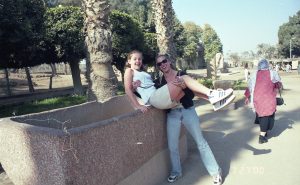
Little is left of this ancient city, some broken columns and walls, but there is a good museum. The best object here is a huge limestone statue of Ramses II that lies in the museum. Outside are a number of sarcophagi; Alex was in danger of being entombed in one by Krysi.
One the way to Memphis, we stopped at a rug factory, staffed with child workers. They like having children because their smaller hands can tie finer knots in the rugs. They say this is a good thing for the girls because they get paid and free schooling in the afternoon, in a country where most kids can’t afford to attend school. I wanted to tip the little girl but asked if she’d get to keep the money. Bill said yes so I gave her some cash, I hope she did get to keep it.

Saqqara or Sakkara is the site of the oldest stone pyramid in Egypt, the Step Pyramid of the Pharaoh Djoser. Built by his architect, Imhotep, in the 3rd dynasty (2649-2575 BC) it has been undergoing restoration for over 70 years. It earned both Djoser and Imhotep lasting fame. Imhotep was later deified and regarded as patron saint of architects and doctors.
Saqqara is a huge complex containing many pyramid complexes and countless tombs from all eras of Egyptian history, including several animal necropolises. The most famous is the Serapeum, where they mummified the Apis Bulls. I could easily spend a full day here at the various sites; we had about an hour and a half. These package tours really rush you along, and it’s one of many reasons I don’t usually take them.
We did see the Step Pyramid and attached mortuary temple, as well as numerous workers at the active digs. There is on-going work here. They announced a newly found queen’s pyramid at Saqqara during Egyptologist Conferences going on in Cairo when we were still there. It contained text from the Book of the Dead.
We traveled halfway around the world to see the Great Pyramids at Giza, the only remaining of the Seven Wonders of the Ancient World. The site at Giza consists of nine pyramids from the 4th dynasty, the great pyramid built for Khufu, the pyramid of his son, Khafre and his grandson, Menkaure, as well as 6 smaller pyramids of the queens. It also has several thousand mastabas, or large trapezoid shaped tombs. And of course, we visited the Great Sphinx. Built over 5000 years ago, they are all amazing.
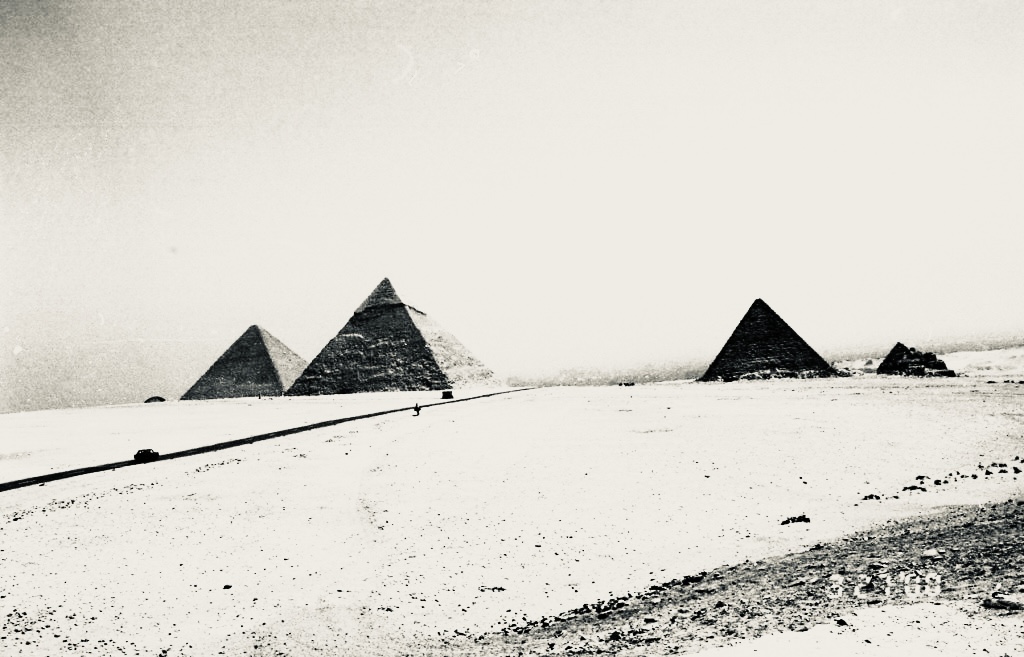
Prior to this trip, I’ve never been more excited to see anything in my travels. We went to the viewing area where you can see the entire site before going to visit the pyramids. Even more amazing close up, it’s not hard to imagine the thousands of workers laboring decades to raise these huge stones. They only allow 100 people in the great pyramid each morning and afternoon, at 0800 and 1300. Most of us wanted to go into the pyramid at 1300 but Bill wanted us to be back at the bus by 1315. We said no! He said go.
 We first visited the boat museum to see the “solar bark”, found in 1954 and believed to have carried the body of Pharaoh Khufu across the Nile to his tomb at Giza. The boat was reconstructed directly above the site where it was found, next to the pyramid and covered by enormous limestone blocks.
We first visited the boat museum to see the “solar bark”, found in 1954 and believed to have carried the body of Pharaoh Khufu across the Nile to his tomb at Giza. The boat was reconstructed directly above the site where it was found, next to the pyramid and covered by enormous limestone blocks.
After visiting the museum, we waited in line for the limited tickets to enter Khufu’s tomb, the Great Pyramid. The look on Alex’s face as she entered the doorway was not an act, she really was a little nervous. We entered from the north side, blasted open during the 9th century by the Caliph Ma’mum in his search for treasure. There is a long, curving, dark passage leading to a steep, low corridor rising to the “Queen’s Chamber”. This room was actually used for burial goods. Another steep passage, called the “Grand Gallery” led to the King’s burial chamber high in the middle of the pyramid.
Climbing down is more difficult than going up, even bent over I kept banging my head on the ceiling because the passageway is sloped down. It was amazing being inside; you could feel the age and mystery associated with this ancient tomb. I purchased a camera ticket but since you couldn’t use flash (which didn’t stop some people) I had to be very still to get a decent photo (and they weren’t that good regardless). So glad I did purchase the extra ticket though. We continued up and up until getting to the burial room where the stone sarcophagus remains. I loved it, this was why I had come to Egypt. We only had a short time, though, since Bill did ask us to be back by 1400. So we didn’t visit any of the queens’ pyramids after leaving the Great Pyramid.
“Man fears time but time fears the pyramids”
Arab proverb
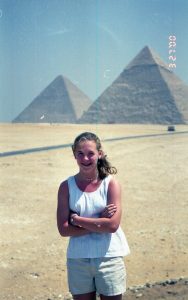 After returning to the bus we drove over to the Great Sphinx, believed to be “living image”of Pharaoh Khufre or Cheops. In Arabic, it is called Abu el-Hol or Father of Terror. The monument has been completely buried in the sand and lost many times. Due to the erosion of wind and sand, plus the cannons of the Mamelukes who used the Sphinx for target practice, the face is almost completely worn away. They were doing additional digging around the area when we visited, believing there were tunnels leading to the pyramids.
After returning to the bus we drove over to the Great Sphinx, believed to be “living image”of Pharaoh Khufre or Cheops. In Arabic, it is called Abu el-Hol or Father of Terror. The monument has been completely buried in the sand and lost many times. Due to the erosion of wind and sand, plus the cannons of the Mamelukes who used the Sphinx for target practice, the face is almost completely worn away. They were doing additional digging around the area when we visited, believing there were tunnels leading to the pyramids.
Alex had ridden a camel many years ago at a medieval jousting festival when she was about 8 and her only comment was “camels smell!” But riding a camel through the Sahara, around the pyramids and past the Sphinx was amazing. We really enjoyed our 45 minute ride. I was a little concerned about getting off since camels fold their front knees and kneel down and I thought I’d go flying over its head, but all was well. After that, we had a long stop at a perfume shop. They hurried us from the pyramids for more shopping? Another reason not to take package tours.
After returning to the hotel and rinsing off sand, Krysi, Monika, Mark, Paul, Barry and I all met at the Pizza Hut right across from the perfume store, facing the Sphinx. The “kids” wanted to stay downtown for a while so Alex went for a horse-back ride with Paul Casebolt and Mark, Krysi and Monika Weircioch.
Wednesday, March 29. Our bus left at 0730 for a full day tour of Cairo. The city was huge, crowded, noisy, and, sorry to say, ugly. It is composed of entirely brown concrete. No paint decorates any of the builds, perhaps the heat and sand would ruin the paint immediately anyway. But it makes for a very somber looking town. The traffic was incredible too. On a 3-lane road, there would be 5 lanes of traffic. No one paid any attention to the lines on the road or, seemingly, any traffic laws. It made for “interesting” traveling to say the least. But I really did enjoy our taxi rides around town, however.
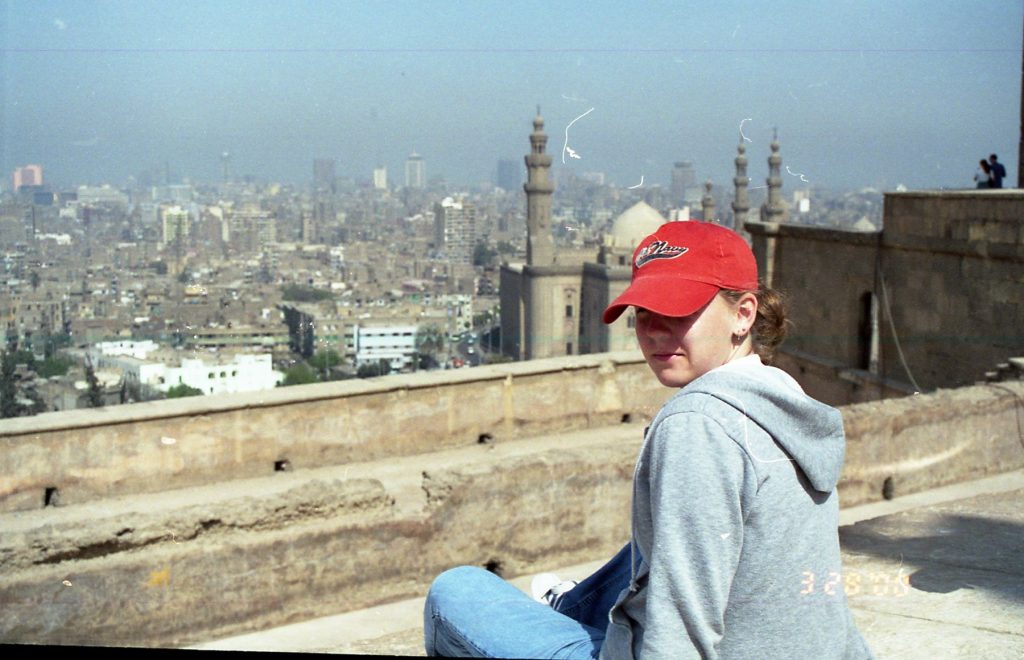
We spent only 4 days in Cairo, from visiting the fabulous Egyptian Museum, crammed full of treasures, to shopping and seeing the huge fortress of the Citadel, but mostly in the suburbs of Giza. Over 1000 years old, the city has been ruled by the Persians, Greeks, Romans, Fatimads, Mamluks, Ottomans, French and the British. Each new ruler built onto the city giving Cairo a number of distinct districts. Although Cairo has a large Christian population, it is still predominately Islamic and known as the City of a Thousand Minarets. It was wonderful to hear the lyrical calls to prayer five times a day coming from the tall towers.
We started our tour at the Hanging Church, or a “Mary” church. Built in the 9th century on top of a gatehouse of the Roman fortress, this church hangs between two old columns. Dedicated to the Virgin Mary, it is believed to be one of the places Mary stopped with baby Jesus while on exile in Egypt from Herod. Up a flight of stairs is a covered courtyard and inside is the nave. It contains a marble pulpit, believed to be the oldest in the country. The sanctuary screen is made of ivory and cedar, to form a cross, and also shows icons of Christ in the middle, with Mary, Archangel Gabriel, St. Peter, St. John the Baptist, St. Paul and Archangel Michael on the arms of the cross.
We visited the Citadel of Saladin, or el-Qala, a large fortress on a hill overlooking Cairo. Built in the 11th Century by Salah al-Din, Egypt was ruled from here for 700 years. Little remains of the original complex, it was rebuilt in the 1330s by al-Nasir Muhammad and again in the 1830s by Muhammed Ali, an Albanian soldier sent to free Egypt from French occupation.
The mosque of Sultan Hassan is one of the largest Islamic buildings in the world. Built by the Mamluk Sultan Hassan in the 13th century, historians believe that it used stone taken from the pyramids at Giza. The mosque dominates the Cairo skyline. The courtyard has a clock tower given to Muhammad Ali by King Louis Philip of France in exchange for the obelisk that stands in Paris’s Place de la Concorde. France got the better deal since the clock has never worked. The mosque is very ornate, considered gaudy by many. It is faced in alabaster with lines of red, green and gold. It has two minarets even though ottoman law decreed that only the Sultan, in Istanbul, may have more than one.
Our final stop for the day was the Egyptian Museum, home of the world’s largest collection of Egyptian artifacts. I could have easily spent days in the Egyptian Museum. We had about three hours to see a fraction of the 100,000 items. We saw Nofret, from the 4th dynasty, a limestone bust of Queen Nefertiti, and the funeral mask of Tut-Ankh-Amon. The Tut-Ankh-Amon display was amazing. We also saw the royal Mummy Room containing 30 royals including Ramses II. There are so many great exhibits here.
We were dropped off at Mena House after the museum. The Wierlochs had invited us for “tea”, so Barry, Paul, Alex and I went with them and had excellent pastries in one of their restaurants. After that we joined Krysi, Monika and Mark, and spent about an hour at their great pool.
Thursday, March 30. We had a free day, so we slept in after many early mornings. After breakfast we took a taxi to Mena House and picked up Krysi to go shopping in Giza. The driver offered to escort us around all day, but wanted way too much money, so we politely got rid of him. Krysi and her sister Monika both got henna tattoos in Aswan and, after seeing them, Alex wanted one, too. We spent part of the last day wandering Giza, shopping and looking for a tattoo artist. We were taken to a perfume shop but after waiting for quite a while were were told to go to a beauty parlor. We had to wait there, too, so wandered the area for a while before returning.
Like everywhere in Egypt, there were many people asking for “baksheesh”, tips or money. There was one young boy and his sister who were selling travel size packages of tissues. It was just a few coins but Alex gave them both 5LE (Egyptian pounds) and their smiles lit up the street. We returned to the beauty parlor and all 3 of us got henna tattoos. Then we returned to Mena House and had a late, late lunch at their restaurant overlooking the pyramids. Alex and I went back to our hotel. We tried the pool, it was very cold, so instead Alex spent time playing ping pong with Paul while Barry and I had drinks at the bar. We went to bed early, around 1900, we had to get up at 0230 for a 0330 bus to the airport.
Friday, March 31. We had a long drive back to the airport, all of us went together. Some had 0600 flights, 0630, 0640, ours left for Paris at 0700. We got to Paris before noon then had a 4-hour layover. We had a long flight to Chicago, arriving around 1700 local time, we made it through customs and to our car by 1800. Unfortunately, the busiest time for Chicago’s rush hour traffic so we didn’t make it home until around 2200.
Egypt is a land of great contrasts. An ancient civilization beyond comprehension, with monuments, temples and tombs dating back over 5000 years, new buildings are sprouting constantly to house its growing population. Rich in history and culture, Egyptians suffer under a 28% unemployment rate that forces many of its young men to take jobs in other countries. The fertile Nile valley where 60 million live stands in sharp contrast to the barren waste of the Sahara that makes up over 90% of Egypt. The crushing poverty and crowding along the Nile have caused serious environmental concerns. Cairo has improved its air quality recently but has one of the world’s most toxic lead levels. Garbage is piled in alleys, along the canals, and thrown from boats into the Nile. Cairo is the second safest city in the world, after Tokyo, yet many expect the terrorism and violence that is associated to the Middle East. I would happily return for a longer visit.
** All photos property of Lisa, not to be copied or reproduced **
